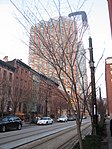Whittier House (Jersey City, New Jersey)
Whittier House was an American social settlement, situated in the midst of the densely populated Paulus Hook district of Jersey City, New Jersey. Christian, but non-denominational, its aims were to help all in need by improving their circumstances, by inspiring them with new motives and higher ideals, and by making them better fitted by the responsibilities and privileges of life. It cooperated with all who were seeking to ameliorate the human condition and improve the social order. It opened in the People's Palace, December 20, 1893. On May 14, 1894, it incorporated and moved to 174 Grand Street.Founded by Cornelia Foster Bradford and named after John Greenleaf Whittier, Whittier House was the first settlement in New Jersey. Its archives, a collection of records spanning the period of 1894 to 1974, are held by the New Jersey Historical Society.
Excerpt from the Wikipedia article Whittier House (Jersey City, New Jersey) (License: CC BY-SA 3.0, Authors).Whittier House (Jersey City, New Jersey)
Grand Street, Jersey City
Geographical coordinates (GPS) Address Nearby Places Show on map
Geographical coordinates (GPS)
| Latitude | Longitude |
|---|---|
| N 40.71593 ° | E -74.04169 ° |
Address
Grand Street 180
07304 Jersey City
New Jersey, United States
Open on Google Maps








